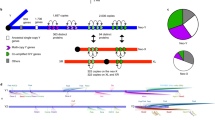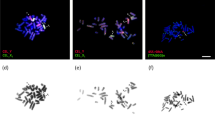Abstract
Sex chromosomes are generally believed to have descended from a pair of homologous autosomes. Suppression of recombination between the ancestral sex chromosomes led to the genetic degeneration of the Y chromosome1. In response, the X chromosome may become dosage-compensated1,2. Most proposed mechanisms for the degeneration of Y chromosomes involve the rapid fixation of deleterious mutations on the Y1. Alternatively, Y-chromosome degeneration might be a response to a slower rate of adaptive evolution, caused by its lack of recombination3. Here we report patterns of DNA polymorphism and divergence at four genes located on the neo-sex chromosomes of Drosophila miranda. We show that a higher rate of protein sequence evolution of the neo-X-linked copy of Cyclin B relative to the neo-Y copy is driven by positive selection, which is consistent with the adaptive hypothesis for the evolution of the Y chromosome3. In contrast, the neo-Y-linked copies of even-skipped and roundabout show an elevated rate of protein evolution relative to their neo-X homologues, probably reflecting the reduced effectiveness of selection against deleterious mutations in a non-recombining genome1. Our results provide evidence for the importance of sexual recombination for increasing and maintaining the level of adaptation of a population.
This is a preview of subscription content, access via your institution
Access options
Subscribe to this journal
Receive 51 print issues and online access
$199.00 per year
only $3.90 per issue
Buy this article
- Purchase on Springer Link
- Instant access to full article PDF
Prices may be subject to local taxes which are calculated during checkout


Similar content being viewed by others
References
Charlesworth, B. & Charlesworth, D. The degeneration of Y chromosomes. Phil. Trans. R. Soc. Lond. B 55, 1563–1572 (2000).
Marin, I., Siegal, M. L. & Baker, B. S. The evolution of dosage-compensation mechanisms. BioEssays 22, 1106–1114 (2000).
Orr, H. A. & Kim, Y. An adaptive hypothesis for the evolution of the Y chromosome. Genetics 150, 1693–1698 (1998).
Lahn, B. T., Pearson, N. M. & Jegalian, K. The human Y chromosome, in the light of evolution. Nature Rev. Genet. 2, 207–216 (2001).
Carvalho, A. B., Lazzaro, B. P. & Clark, A. G. Y chromosomal fertility factors kl-2 and kl-3 of Drosophila melanogaster encode dynein heavy chain polypeptides. Proc. Natl Acad. Sci. USA 97, 13239–13244 (2000).
Powell, J. R. Progress and Prospects in Evolutionary Biology: The Drosophila Model (Oxford Univ. Press, New York, 1997).
Schaeffer, S. W. & Miller, E. L. Molecular population genetics of an electrophoretically monomorphic protein in the alcohol dehydrogenase region of Drosophila pseudoobscura. Genetics 132, 163–178 (1992).
Gethmann, R. C. Crossing over in males of higher Diptera (Brachycera). J. Hered. 79, 344–350 (1988).
Steinemann, M. & Steinemann, S. Enigma of Y chromosome degeneration: neo-Y and neo-X chromosomes of Drosophila miranda a model for sex chromosome evolution. Genetica 102–103, 409–420 (1998).
Waters, P. D., Duffy, B., Frost, C. J., Delbridge, M. L. & Graves, J. A. The human Y chromosome derives largely from a single autosomal region added to the sex chromosomes 80–130 million years ago. Cytogenet. Cell. Genet. 92, 74–79 (2001).
Das, M., Mutsuddi, D., Duttagupta, A. K. & Mukherjee, A. S. Segmental heterogeneity in replication and transcription of the X2 chromosome of Drosophila miranda and conservativeness in the evolution of dosage compensation. Chromosoma 87, 373–388 (1982).
Li, W. Molecular Evolution (Sinauer Associates, Sunderland, Massachusetts, 1997).
Yi, S. & Charlesworth, B. Contrasting patterns of molecular evolution of the genes on the new and old sex chromosomes of Drosophila miranda. Mol. Biol. Evol. 17, 703–717 (2000).
Wang, R. L. & Hey, J. The speciation history of Drosophila pseudoobscura and close relatives: inferences from DNA sequence variation at the period locus. Genetics 144, 1113–1126 (1996).
Kimura, M. The Neutral Theory of Molecular Evolution (Cambridge Univ. Press, Cambridge, 1983).
Wright, S. Evolution and the Genetics of Populations (Univ. of Chicago Press, Chicago, 1969).
Bachtrog, D. & Charlesworth, B. Reduced levels of microsatellite variability on the neo-Y chromosome of Drosophila miranda. Curr. Biol. 10, 1025–1031 (2000).
Filatov, D. A., Moneger, F., Negrutiu, I. & Charlesworth, D. Low variability in a Y-linked plant gene and its implications for Y-chromosome evolution. Nature 404, 388–390 (2000).
Yang, Z. PAML: a program package for phylogenetic analysis by maximum likelihood. Comput. Appl. Biosci. 13, 555–556 (1997).
McDonald, J. H. & Kreitman, M. Adaptive protein evolution at the Adh locus in Drosophila. Nature 351, 652–654 (1991).
Barton, N. H. Genetic hitchhiking. Phil. Trans. R. Soc. Lond. B 355, 1553–1562 (2000).
Hudson, R. R., Kreitman, M. & Aguade, M. A test of neutral molecular evolution based on nucleotide data. Genetics 116, 153–159 (1987).
Lynch, M. & Blanchard, J. L. Deleterious mutation accumulation in organelle genomes. Genetica 102–103, 29–39 (1998).
Fridolfsson, A. K. & Ellegren, H. Molecular evolution of the avian CHD1 genes on the Z and W sex chromosomes. Genetics 155, 1903–1912 (2000).
Maynard Smith, J. The Evolution of Sex (Cambridge Univ. Press, Cambridge, 1978).
Barton, N. H. & Charlesworth, B. Why sex and recombination? Science 281, 1986–1990 (1998).
Bell, G. The Masterpiece of Nature (Univ. of California, Berkeley, 1982).
Tajima, F. Statistical analysis of DNA polymorphism. Jpn J. Genet. 68, 567–595 (1993).
Hudson, R. R. in Oxford Surveys in Evolutionary Biology Vol. 7 (eds Futuyma, D. & Antonovics, J.) 1–44 (Oxford Univ. Press, Oxford, 1990).
Weiss, G. & von Haeseler, A. Inference of population history using a likelihood approach. Genetics 149, 1539–1546 (1998).
Acknowledgements
We thank P. Andolfatto, N. Barton, D. Charlesworth, I. Gordo, P. Keightley and S. Wright for helpful comments on the manuscript. D.B. is supported by a Marie Curie fellowship and B.C. by the Royal Society.
Author information
Authors and Affiliations
Corresponding author
Ethics declarations
Competing interests
The authors declare no competing financial interests.
Rights and permissions
About this article
Cite this article
Bachtrog, D., Charlesworth, B. Reduced adaptation of a non-recombining neo-Y chromosome. Nature 416, 323–326 (2002). https://doi.org/10.1038/416323a
Received:
Accepted:
Issue Date:
DOI: https://doi.org/10.1038/416323a
Comments
By submitting a comment you agree to abide by our Terms and Community Guidelines. If you find something abusive or that does not comply with our terms or guidelines please flag it as inappropriate.



